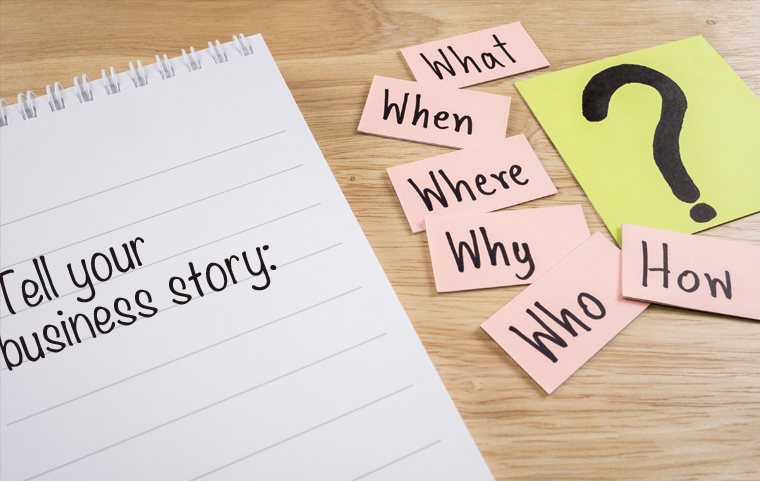Rudyard Kipling got in right when his 1902 poem from “The Elephant’s Child” opened with:
I keep six honest serving-men
(They taught me all I knew);
Their names are What and Why and When
And How and Where and Who.
It’s as true today as it was then. A well-told story includes these elements: who, what, when, where, why and how. How well are you telling your business story in your marketing and website? Use this checklist to make sure it’s a story your customers will love.
Why
Start with your why. Simon Sinek, in his 18-minute TED Talk, outlines a compelling case for opening your business story with “Why you do what you do?” If you can articulate the passion, the mission, the true big-picture reason that your company is in business, you’ll instantly connect with people who believe in the same things you do. Chances are, those are the exact customers, partners and influencers you want to meet. By first connecting emotionally around a shared belief, those people – your people – are already interested.
“We believe the globe is filled with rich, untapped experiences,” one travel agency might say. An electric car company could claim, “We believe that a healthy earth offers an amazing playground for people everywhere.” Simon Sinek articulates Apple’s Why like this, “We aim to challenge the status quo. We aim to think differently.”
Your Why is the core belief of your company. What you do, how you do it, who you do it for…all that comes after.
Who
Who, really, are you in business to serve? Be specific. Think about your best and favorite customers. What do you know about them? What is their gender, age, location, interests, education level, level of affluence, industry, business type within that industry and job title?
Think of your Who as a specific person (or persons). Name each customer profile (Malik Marketer, Beatrice Business Owner, Isabela Investor…) and assign specific attributes to bring each “persona” to life in your mind. You may have more than one, but if you have more than two or three, you may be trying to serve too broad of a customer base and you risk watering down your story and missing an opportunity to connect with your very best customers.
Do you serve “tech-savvy consumers”? “Environmentally conscious manufacturing business owners?” “Leisure international jet-setters?” “Online retail entrepreneurs who have been in business 1-3 years?” When you’re specific, your potential customers can start to picture themselves as your customers, knowing that you already understand some of their challenges.
What
Every business owner and leader knows what they sell. Not everyone, though, is good at describing their products and services from a customer perspective.
What customer problem do you solve? What value do you offer? How do you change or improve your clients’ personal or professional lives because of your services?
In our experience, getting this right is one of the most difficult parts of telling your story. Most businesses think that if they know the benefits of what they offer, their customers will, too. But that’s often not the case. Try to explain what you do in simple terms. Avoid industry jargon. Yes, try to describe what you do to your grandmother – in terms she understands.
If you sell mapping apps for phones, you might proudly claim, “Our state-of-the-art mapping software has real-time location data with built-in layers for roadwork, traffic and weather.” Your grandmother, though, wants this, “A map on your phone that tells you exactly where you are and the best way to get where you want to go. You’ll save time and never get lost.”
Where
This one is so simple, it’s often overlooked when telling your business story. Where do you conduct your business? Where do your customers live, purchase and gather? Do you go to your customers? Must they come to you? Is all your business online?
Customers can’t drive to an eBay store. Merry Maids always goes to their customers’ homes and offices. Starbucks drinkers can stop by a store, order coffee online or pick up some grounds in their local supermarket. The local pizza shop does not deliver overseas.
There is no “best” location. And your Where may evolve over time. Just check to make sure your customers know how to get to you if they want to.
When
When is tricky, but important. When goes well beyond your hours of operation. When, too, is about how quickly you will solve your customer’s problems. When will they feel relief or resolution? What will the process look like along the way?
When completes the picture for your customers. Include your When to help customers imagine the end benefit of what you offer.
How
Like Where, How is about acquiring your customers. How are you different from similar businesses? How do you intend to grow your business over time? Will you get bigger (more scalable and less personable)? Will you add more services?
Your How can be the deciding factor for customers. If what you do differently is something that customers value, it can be the basis of your brand differentiation.
Putting it Together: Your Positioning Statement
Once you’ve completed your audit of who you are and what you do, put together your story – your company’s Positioning Statement to use in marketing.
See if your story fits here: We believe [Why]. Our Company helps [Who] accomplish [customer benefits] by [How – doing, offering, delivering] [What] [Where] and [When].
A strong positioning statement can be more complex than this, but if you can fill in the blanks, you have a great start. You have all the elements of a great story to share with customers.
Coming up with your own positioning statement and branding is a challenge for most companies. It usually takes an outside perspective to get it right. If you’re looking for support in refreshing your brand, let us know. We’d be happy to help!
— Elizabeth Doubleday, Marketing Strategist

